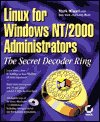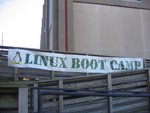Getting in Touch with My Inner Geek, Part 2
 I spent a little time over the Thanksgiving holiday to experiment with SUSE Pro 10.0* and try some "everyday" things. My windows of time to work with Linux are few and far between, so don't laugh at my small victories.
I spent a little time over the Thanksgiving holiday to experiment with SUSE Pro 10.0* and try some "everyday" things. My windows of time to work with Linux are few and far between, so don't laugh at my small victories.- I was *finally* able to get the thing installed from ISOs. YaST gave me all kinds of trouble, even though I ran through the "check media" process. It would tell me disc x was not inserted, but eventually it did work and I got through it. (BTW, I burned these at 16x, 8x, and 4x -- and all had the same result. May be my drive?)
- SUSE 10 correctly detected my network card and wireless card by name. I tested the Gigabit Ethernet card on Monday at work, and it worked! Haven't worked on the wireless much...
- Learned how to change the hostname.
- Successfully connected my USB jumpdrive, found /media/usbdisk, and copied files to and from it.
- Discovered by accident that SUSE 10 automatically mounts my Windows/C drive and all its contents as a browsable folder! (This is both good and bad. I didn't explore it much to see if my protected folders are still protected.)
- Played around with various settings in Control Center and System Configuration (YaST and SaX2): changed screen resolution, wallpaper, mouse speed, user images, and the default background and greeting on the login page.
- Attempted to run PersonalBrain 3.x using WINE, but it failed. I looked it up today in the WINE HQ application database and found someone has already submitted it, but there are no maintainers. This seems like a rather advanced topic, so I will work my way up to it and maybe contribute!
- Attempted to run Microsoft Access 2000 using WINE, but it also failed. I see today that it is supported, so I will explore the documentation eventually.
 - Re-read the first 150+ pages of Linux for Windows NT/2000 Administrators (Sybex, 2000) which I highly recommend for anyone dipping their toes for the first time, even though it's a bit dated.
- Re-read the first 150+ pages of Linux for Windows NT/2000 Administrators (Sybex, 2000) which I highly recommend for anyone dipping their toes for the first time, even though it's a bit dated.- Successfully, I think, installed Ubuntu Linux 5.10 on some free space.
Current "Projects"
Wireless connection: My wireless card is correctly detected by name in YaST, but ifconfig only shows eth0, my Gigabit ethernet card, as activated. Tried entering settings for wireless network, but haven't gotten any further. Found some notes on iwconfig that I will explore soon, unless you guys have another suggestion.
Trying to add Ubuntu 5.10 as an option in /boot/grub/menu.lst. I got "Ubuntu 5.10" to appear as a menu item, but couldn't figure out what boot string to use so that it works.
Next Things to Try
- Citrix client, for use at work
- Burn a data CD, then a music CD
- Play music
- Fonts
- Instant Messaging, so I can get help while working in Linux
- 5250 telnet emulator, for use to access my IBM iSeries at work
Labels: technical








